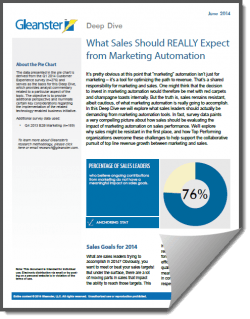 The benefits of marketing automation are clear—better customer engagement, increased loyalty, and more effective campaigns. But what can your organization realistically expect in terms of sales?
The benefits of marketing automation are clear—better customer engagement, increased loyalty, and more effective campaigns. But what can your organization realistically expect in terms of sales?
- How about a 2x higher bid-to-win ratio for the top 20% of your sales reps?
- Or would you prefer an average of 1.5x higher revenue year-over-year?
Perhaps you’d settle for both?
Gleanster Research has just published a fine new report, “What Sales Should REALLY Expect From Marketing Automation.” It’s based on results from two recent (Q1 2014 and Q4 2013) studies.
The report lays out specific sales challenges and measures them against how marketing automation can help sales work smarter, faster, more efficiently, and more effectively – and what sales can expect from a well-implemented automation platform.
Among the survey respondents, sales leaders at companies that had adopted marketing automation did see that 2x higher bid-to-win ratio for the top 20% of reps, and did get 1.5x higher revenue year-over-year. In addition:
- 82% saw significant improvement in lead quality
- 89% reported sales cycle time was tightened
- Of those using a CRM, 76% saw reps increase their usage of the CRM
Marketing automation is a tool for lead to revenue management
As the study points out in the beginning, “marketing automation” is a misnomer; it’s really a tool for optimizing the path to revenue. (That’s probably why Forrester Research chooses to use the term “Lead to Revenue Management” system to refer to marketing automation platforms.)
Given what marketing automation can do for your sales, it may seem surprising that sales isn’t leading the charge to adopt marketing automation; what’s not to like about a system that boosts revenue? The answer to that may lie in the context sales operates in.
The difficult sales environment, Part 1: External forces
It’s a noisy world out there. Your buyer is assaulted by marketing and advertising noise from a million channels, and tunes it out – except when they’ve decided they want something. Then they go online to look for solutions. That’s where they begin in their buyer’s journey, and that’s where they stay for most of the journey, doing research, reading reviews, and asking for opinions from others in social media. And that’s where they will find you, if you’ve got the answers they’re looking for. (And if you’re doing optimized content marketing.)
They won’t be ready to talk to you until they’ve already made a lot of decisions – likely with the input and feedback from other members of the buying committee. Fewer decisions are made by just one person nowadays, which is just one more reason the average sales cycle has gotten longer.
The difficult sales environment, Part 2: Internal forces
Most sales teams function in a very dynamic environment, and they don’t have control over all the moving parts. They’ve got finding, coaching and keeping talent on the one hand; product quality and delivery on the other; and forecasting and quota management on still another.
Every department in a company has a role to play in sales enablement, particularly marketing. According to Gleanster’s Q4 2013 data, only 32% of marketers pass leads to sales that are qualified by budget, authority, need, and timeline (BANT). That means that in almost 70% of organizations, sales reps are spending valuable time qualifying leads – not closing them. Too many reps spending too much time on too many activities that aren’t focused on closing = major pain.
If you’re a sales leader in this position, here’s the key question: What can you do to help your reps spend more time selling and less time prospecting?
And here’s the answer: Outsource lead generation and qualification to your marketing department. And make sure marketing knows what you require from a marketing automation platform.
What to ask for from marketing automation
Here’s what a good marketing automation system should be able to do for the sales team:

Take over lead qualification.
Yes, much of this can be done by marketing automation today. The best leads will display their interest by engaging with you: visiting your web pages, opening your emails, registering for your webinars, downloading your white papers, filling out your forms. It’s marketing automation’s job to see this, track it, note it, and report it.
Score leads.
Trot out your BANT criteria and assign point values to each. For example, suppose you have good customers in a manufacturing vertical who bought your product because their pain registered as a 7 on a 1 to 10 scale, and your product solves that problem. A new lead in that vertical gets a good score. Now suppose that you have great customers in a logistics vertical whose pain registered as a 9 … they bought because your product solved an even more painful problem, and they bought a bigger package. The new lead in logistics gets a higher score than the one in manufacturing.
Score actions.
For example, if people who became your customers tended to download your pricing brochure, then give that download action a high score. Pretty soon some leads – those with better BANT criteria and those who actions indicate a higher degree of sales-readiness – will have high scores that tell you “We are ready for sales.”
Tell sales when something important happens.
Want to know when John Doe visits your Product X page? Set an alert in the marketing automation system – they work 24/7. Want to know when someone from Company B visits your website, and which pages they look at? Check your Website Visitor Tracking report (or set an alert.)
Help sales find new buyers.
Your marketing team can use automation to do inbound marketing with forms, landing pages, SEO optimization, social publishing options, and a lot more.
Help those buyers trust your company.
Your marketing team can also use content marketing to extend your brand, create credibility and trust, and draw in the likeliest buyers. If your content is good, marketing automation can help you distribute where it will be appreciated, and most likely to be acted on. When someone finds your website, reviews your content, and then signs up for a demo, marketing automation will tell you who that person is and what they’re interested in.
Get leads through the whole funnel, alive.
With longer sales cycles and more complex deals, you absolutely must nurture leads. You and your marketing team should first segment your leads into groups, ideally with characteristics that are unique to each group. The less overlap, the better. Use trial and error with a beta group to figure out which nurturing path works the best, and then replicate that path with automation. New leads can enter the program at the beginning and proceed, never missing a step. It’s always-on, tireless communication – and it scales for as long as it takes, for as many leads as you get. It’s also hard work … the kind you can’t possibly do manually.
(Here’s a tip: Nurtured leads often make bigger deals. Just sayin’.)
Help sales close leads.
Your marketing automation system should integrate all the data that results from prospects’ interactions with all its features into one complete situational awareness package that is unique to each lead.
When a lead’s score gets high enough, that lead will automatically be pulled into the CRM system and handed to the sales rep. The rep can see every email the lead opened, every webinar attended, every page visited, and all downloads. Behavior patterns throw the prospect’s concerns into high relief, revealing what matters to that lead – and giving the sales rep the inside intelligence to say just the right thing.
Integrate with your CRM.
Most marketing automaton platforms can do this. The one thing to watch for here is which database, CRM or marketing, is the database of record. Ultimately the decision needs to remain in the hands of the customer. There are scenarios (like cost control) where you might not want 100% of your marketing database in your CRM.
(One best practice we at Act-On employ is passing only Sales Ready Leads from Act-On to our CRM. This keeps your CRM storage cost down and performance unaffected.)
The new Gleanster paper goes into a lot more detail about what marketing automation can do for your sales team and how it accomplishes those benefits. It sets realistic expectations and addresses the question of disruption with tactics to minimize adoption setbacks.
Download the paper, and then give us a call. We’d love to show you what Act-On’s marketing automation can do for your sales.

